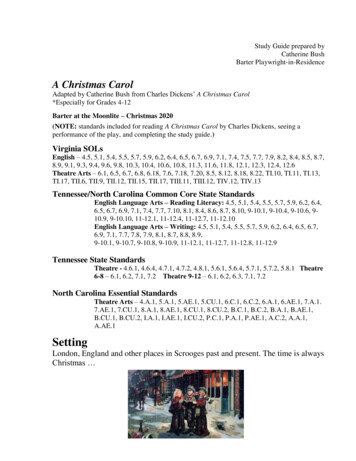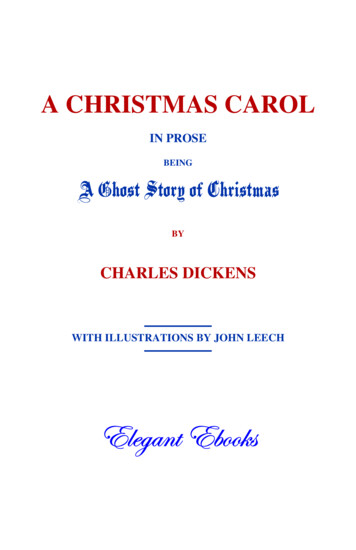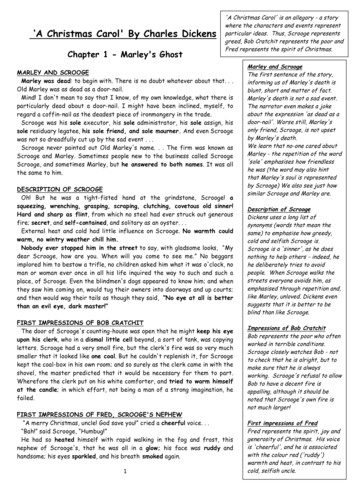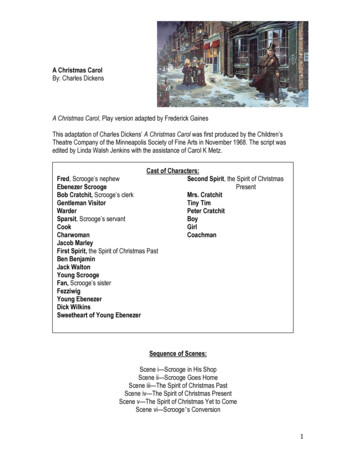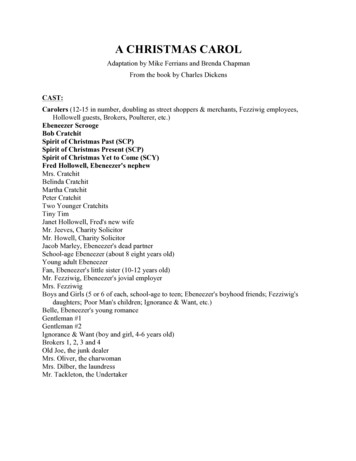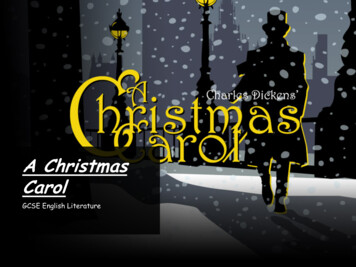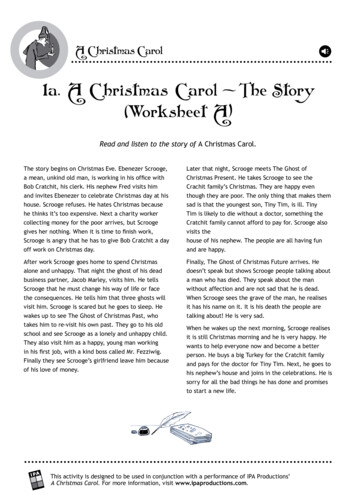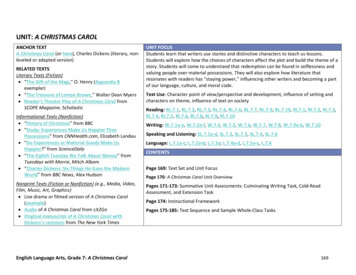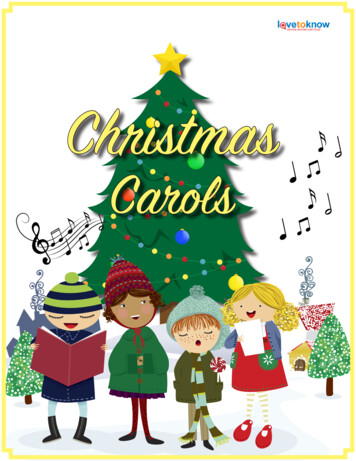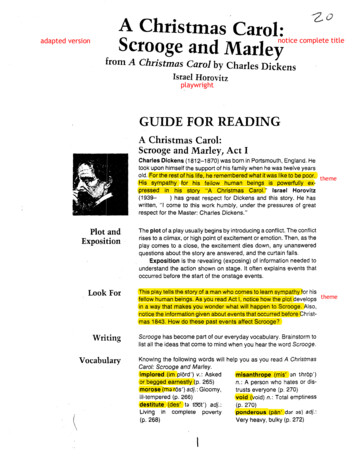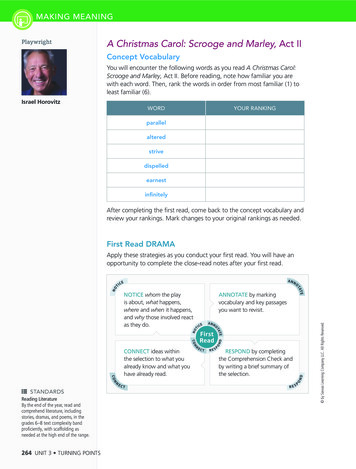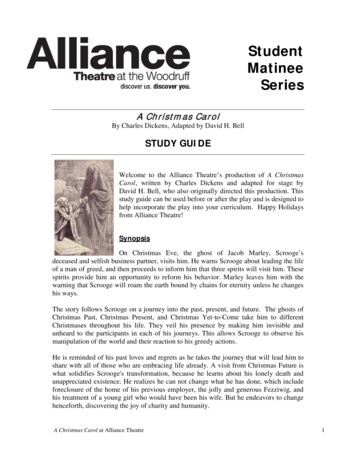
Transcription
StudentMatineeSeriesA Christm as CarolBy Charles Dickens, Adapted by David H. BellSTUDY GUIDEWelcome to the Alliance Theatre’s production of A ChristmasCarol, written by Charles Dickens and adapted for stage byDavid H. Bell, who also originally directed this production. Thisstudy guide can be used before or after the play and is designed tohelp incorporate the play into your curriculum. Happy Holidaysfrom Alliance Theatre!SynopsisOn Christmas Eve, the ghost of Jacob Marley, Scrooge’sdeceased and selfish business partner, visits him. He warns Scrooge about leading the lifeof a man of greed, and then proceeds to inform him that three spirits will visit him. Thesespirits provide him an opportunity to reform his behavior. Marley leaves him with thewarning that Scrooge will roam the earth bound by chains for eternity unless he changeshis ways.The story follows Scrooge on a journey into the past, present, and future. The ghosts ofChristmas Past, Christmas Present, and Christmas Yet-to-Come take him to differentChristmases throughout his life. They veil his presence by making him invisible andunheard to the participants in each of his journeys. This allows Scrooge to observe hismanipulation of the world and their reaction to his greedy actions.He is reminded of his past loves and regrets as he takes the journey that will lead him toshare with all of those who are embracing life already. A visit from Christmas Future iswhat solidifies Scrooge's transformation, because he learns about his lonely death andunappreciated existence. He realizes he can not change what he has done, which includeforeclosure of the home of his previous employer, the jolly and generous Fezziwig, andhis treatment of a young girl who would have been his wife. But he endeavors to changehenceforth, discovering the joy of charity and humanity.A Christmas Carol at Alliance Theatre1
Charles DickensCharles Dickens was born in London in 1812, the son of Elizabethand John Dickens. As a Naval Pay Officer, John Dickens wasimprisoned for debt when Charles was a boy. Consequently,Charles was separated from his family and sent to work in a factorythat produced shoe blacking, one of the most traumatic experiencesof his life. By the age of fifteen, he had progressed to anapprenticeship with an attorney. A prolific writer from the start,Dickens' experience as a freelance and shorthand reporter gave himthe experience to prepare him for a career as a novelist.In the time before he wrote A Christmas Carol, Dickens receivedthe opportunity to lecture at the Atheneum, a charitable institution for the middle class.There he spoke on the education of the poor, a subject he felt passionately about. Fromthis lecture and a visit to the streets of London, his growing sympathy turned to thewriting table. The result of that was A Christmas Carol. Though the book sold sluggishlyat first, it went on to change the face of the holiday season. England once celebratedChristmas as a mixture of Pagan customs and Twelve Days celebrations. Dickens helpedtransform the idea of the Christmas season into what we recognize as such today.Though his novels were generally popular successes, a string of less successful booksprompted his publisher to threaten a reduction in his salary if he did not deliver on thenext book. It was under that pressure that he wrote A Christmas Carol, a book heexpected to fare better than it did initially. He expected his first royalty check to be about 1000, but it turned out only to be 250. Fortunately, the book caught on and has becomethe most celebrated novel of Dickens’ career.Charles Dickens’ other books include Great Expectations, David Copperfeld, ThePickwick Papers, A Tale of Two Cities, and Oliver Twist. Dickens died in 1870.Adapting A Christm as CarolDavid H. Bell, adapter and director of the Alliance’s version of A Christmas Carol,undertook quite a challenge to put this play on the stage. The original story was written innarrative form. Although narrative contains some dialogue, the omniscient narrator cluesus in to the world of the story. However, in a play, sights and sounds tell the story andkeep it moving forward. Because of these factors, dialogue had to be constructed fromthe narrative version to create an adapted play.One of the most original aspects of Mr. Bell’s adaptation is his inclusion of the Victorianwarehouse. The clutter of hundreds of repossessed items represents Scrooge’s greed anddisregard for his fellow man. This is an element of the set that hints at a detail about thestory. When you first walk into the theatre, you will see the clutter of furniture, rugs, andother articles all over the stage. This indicates the foreclosed items.Another interesting aspect of the scenic elements is the way the sets indicate differenttimes and places. The play jumps back and forth to dozens of locations in differentA Christmas Carol at Alliance Theatre2
periods of time. Scenic pieces fly in and out, as if by magic and help the audience knowwhen the scenes are moving into different places.The Industrial RevolutionThe England that existed before the IndustrialRevolution was a country filled with firesideentrepreneurs. Cottage industries, in other words,labored out of the homes of Englishmen. Workingfamilies invested in raw goods and focused on smallscale production. However, by the middle of theeighteenth century, a new work ethic was gainingmomentum. This new direction led to the IndustrialRevolution, calling for mass production in factorysettings. Underpaid, overworked, and able working conditions. The abuse of The children pictured werechildren for use in manufacturing was an alarming among the many employed bypractice. Children laborers were actually sold, in factories during the industrialrevolution. Working conditionsessence, by their families to the factories that employed for children were often inhumanethem; the child would slave away in the factory and before child labor laws weretheir families would receive the child’s salary. Many passed.children tried running away, but most were caught andbeaten severely. In most cases, adult factory workers could not afford to buy what theylabored to make. By the mid-nineteenth century, the England of Dickens was intimatelyfamiliar with industry and the problems associated with it.Charles Dickens' London was one of the world’s most crowded cities, grappling withmajor sanitation, corruption, and crime problems. The streets were horribly crowded withomnibuses, cabs, vendors, carriages, carts, businesspersons, and destitute individuals. In atwelve-hour day, between the hours of nine a.m. and nine p.m. 125,859 vehicles passedthrough the streets – and that does not include foot traffic. One could imagine howDickens' impressions of the world and his expression as a writer was influenced by all thefactors of his world.Money, Money, Money Victorian England Money SystemAmerican Money System4 farthings one penny (d)5 pennies one nickel (.05 or 5c)12 pence (or pennies) 1 shilling (s)10 pennies one dime (.10 or 10c)20 shillings 1 pound ( )25 pennies one quarter (.25 or 25c)A (one) guinea 21 shillings100 pennies one dollar ( 1.00)British money was written in the following order: pounds/shilling/pence ( /s/d).Prices less than one pound generally appeared as shilling/pence (s/d)A Christmas Carol at Alliance Theatre3
The approximate conversion from one Victorian Pound to U.S. Dollar amount 2000 is.One Victorian Pound 100 U. S. Dollars (2002)The number of servants a person employed signaled his or her status in the society ofVictorian England. The basest of social climbers, wanting to be a part of middle classsociety, had at least one servant – the minimum required for middle-class standing. Thisperson's living expenses were covered by the employer; however, beyond that a servanttypically earned a meager sum of 10.00 cash per year. Although the wages earned bylaborers ranged, the sum equated with basic survival was about 40-50 per year.Food as TraditionVictorianEnglandembracedthepreparation and consumption of food aspart of their tradition. The play refers tofoods like Christmas pie, roast goose,turkey, ham, minced pies with spicedoranges, turkeys, geese, game, poultry,brawn, meat, pigs, sausages, oysters, pies,pudding, fruit punch, strong hot gin punch,the dressing of a Christmas goose, pears,apples, nice Spanish onions. And who canforget the plum pudding? Delicate care andcareful attention went into preparation offoods of an English holiday. Note thisexample in the making of plum pudding.This picture depicts a Christmas pudding beingserved to an eager family. In England, puddingis not like the soft mousse-like dessert the namedenotes here in America. English pudding ismore firm and cake-like. "To plum" once meant to rise or swell as we see in the modern, "to plump."To early mild porridge or frumenty (sweet, cooked wheat cereal) were addedlumps of meat, dried fruits such as raisins and currants, rum and brandy,butter, sugar, eggs, and many spices.made in large copper kettles and wereprepared several weeks before Christmas. The making of the pudding wasattended with much ceremony. The entire household was present and eachfamily member took turns at stirring the thick steaming stew.the arrival ofthe plum pudding was the capstone at Christmas dinner, there was alwaysroom, no matter how full the stomach. (Page 68, The Christmas Almanack,Del Re) There was also a ring or thimble placed in the pudding and whoever retrievedit was deemed with the qualities associated with that object, i.e. ring marriage. "Mince pies contain no mince meat and plum pudding has noplums, but the English would never let that fact stand in the way of tradition."(Page 68, The Christmas Almanack, Del Re)A Christmas Carol at Alliance Theatre4
Curriculum ConnectionsCCRR3. Analyze how and why individuals, events, and ideas develop and interact overthe course of a text.CCRR4. Interpret words and phrases as they are used in a text, including determiningtechnical, connotative, and figurative meanings, and analyze how specific word choicesshape meaning or tone.CCRR7. Integrate and evaluate content presented in diverse media and formats,including visually and quantitatively, as well as in words.CCRSL2. Integrate and evaluate information presented in diverse media and formats,including visually, quantitatively, and orally.CCRSL3. Evaluate a speaker’s point of view, reasoning, and use of evidence andrhetoric.CCRL3. Apply knowledge of language to understand how language functions indifferent contexts, to make effective choices for meaning or style, and to comprehendmore fully when reading or listening.CCRL4. Determine or clarify the meaning of unknown and multiple-meaning words andphrases by using context clues, analyzing meaningful word parts, and consulting generaland specialized reference materials, as appropriate.ELACC6-12RH2. Determine the central ideas or information of a primary or secondarysource; provide an accurate summary of the source distinct from prior knowledge or opinions. Grades 6-8 of how key events or ideas develop over the course of the text. Grades 9-10 that makes clear the relationships among the key details and ideas. Grades 11-12A Christmas Carol at Alliance Theatre5
Discussion Questions and Activities1. Have you ever been to a large metropolis, other than Atlanta? If so, describe what itwas like to walk on the streets of that city? What were vendors selling? What noisesdid you hear? What were people on the streets saying? How do you suppose life haschanged in large cities over the last 160 years? How has it stayed the same?2. Do you think that music helps to move this story of reformation and change closer touniversal understanding? After reading the book A Christmas Carol, are there anyplaces where songs are sung? Have you ever been a part of a chorus or carolingtroupe? How does singing make you feel? Do you think that music would help tosolidify the uplifting of attitude?3. Write one short paragraph detailing an experience you've had and regretted. Why didyou regret it? Did your actions harm someone else? How did that make you feel?Now write another short paragraph, but this time write it from the other person'sperspective. How did they feel about what you were doing to them? Were they mador hurt? How did they express that?4. Do you think Scrooge could have had a higher quality of life, had he been moreaware of how his actions affected other people? Do you think it is ever too late tochange? Have you ever known anyone who has made the kind of life transformationthat Scrooge did? How did they do so?5. Bob Cratchit, with a wife and five children to support, earned only 15 shillings aweek. Use the table to convert the amount of Cratchit's weekly pay in shillings, intoa weekly and yearly salary, of American Dollars. Make a one-week grocery list forBob Cratchit and his family, with the approximate dollar amount beside each item.Do they need more food than they can afford?6. Read the dialogue in this scene from A Christmas Carol:ScroogeFive coals, Mr. Cratchit?CratchitBegging your pardon, sir?ScroogeI find you basking in almost tropical warmth, Mr. Cratchit, and discover five coalsburning in our stove when three would have sufficed.CratchitAn oversight, sir.ScroogeThe farthing cost of a coal will be deducted from your week's pay, Mr. Cratchit,and we will enter the ha’ penny in our books as an oversight.CratchitYes, sir. Sorry, sir.ScroogeA Christmas Carol at Alliance Theatre6
You may continue at your work, sir. And mind you, don’t drowse in this stuffyheat.(Scrooge crosses to his office and sits at his large and well-organized desk.)CratchitNo, sir. Thank You, sir.Now, re-write the dialogue using words that are part of your everyday language.For example, if you call people by nicknames, or if there are certain favorite phrasesshared by your group of friends, feel free to use them, however, maintain the essenceof the scene. Did your version make more sense to you? Why or why not?7. A costume designer is very important to any theatre production. The actors come onthe stage, and before they speak a word, the audience associates certain attitudestoward them simply based on their mode of dress. Get out your pens, pencils, paint,scissors, and glue and prepare to be a costume designer. Sketch, paint, or make acollage representing Ebenezer Scrooge. Put his costume into the time and place ofyour production. (Your production doesn't have to take place in Victorian England, itcould be in Japan, or even space.) Feel free to use symbols and colors that will speakto the audience about what sort of man he was. Would his costume change at the endof the play, after he has reformed?8. Name your favorite holiday dish and describe the process by which it is made andpresented. Are there any special rituals that take place? Are there assigned roles?A Christmas Carol at Alliance Theatre7
Other .htmlPertinent information about Dickens, online texts, and outstanding tml"The Industrial Revolution: A Trip to the Past"One of the best available sources for information regarding the Industrial Revolutionbecause it is neatly presented and gives specific and comprehensive information ongeneral and specialty This fun site has games and puzzles. It also provides the user with pertinent informationand many useful links. The site specializes in the relevance of America’s role in theIndustrial er/"Life of the Industrial Worker in 19th-Century England"A wonderful site with journals and documents that detail the working and livingconditions in England during this time period. Maintained by Laura Del tmExtensive information about child labor in England during the Industrial Revolution.Books:Ackroyd, Peter. Dickens. Great Britain: Harper Collins, 1990.Brown, Ivor. Dickens in His Time. Great Britain: Thomas Nelson and Sons Limited,1963.Del Re, Gerard and Patricia. The Christmas Almanack. New York: Doubleday & Co.,1972.Dickens, Charles. The Christmas Books: Volume I: The Christmas Carol and TheChimes. England: The Penguin Group, 1971.Hayes, John. London: A Pictoral History. New York: Arco Publishing Company Inc.,1969.Miles, Clement A. Christmas, Customs and Traditions: Their History and Significance.New York: Dover Publications, 1976.Welsh, Alexander. The City of Dickens. Great Britain: Oxford University Press, 1971.A Christmas Carol at Alliance Theatre8
A Christmas Carol . David H. Bell, adapter and director of the Alliance’s version of , A Christmas Carol undertook quite a challenge to put this play on the stage. The original story was written in narrative form. Although narrative contains some dialogue, the o
